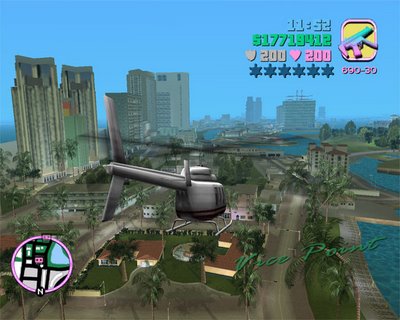Urban Hellraisers in Vice City
On the 21st of November 2005, CSI: Miami (apparently the most popular USA TV show worldwide - certainly one of the most reactionary) featured an episode called 'Urban Hellraisers' in which a fictional videogame of the same name was being used by university students to learn how to commit crimes. The game shared many features with Grand Theft Auto (primarily the cover aesthetics), enough at least to be considered a clear reference to the game.
It is not the first time that gaming has been a theme on CSI:Miami, the episode 'Game Over' from season three shared a similar theme. This time based on the cut-throat game design business and a murder that took place in a special skateboard bowl/ramp which was being used to motion capture special moves for a skateboarding videogame.
So we see one side of Miami confronting the other: CSI: Miami, the official side which often plays on the threatening elements of popular culture (Spring Break, Girls Gone Wild, Marijuana, Videogames - among others) to associate them with serious crimes, and Grand Theft Auto: Vice City - a simulacra of Miami, that draws upon many representations of Miami from popular culture, in particular those associated with crime, drugs, and the creolization of American Culture (in particular with regard to the influence of Latin American and Carribean immirgrants).
This led me to reflect upon the particular status of Miami in American (both North and South) popular culture. One a a few North American cities which has been particularly transformed by Latin culture. Its location makes it the closest part of the North American continent for the Carribean and South American Countries. It could be seen as a liminal zone, which while politically and geographical belonging to North America, culturally it is connected to the South. Indeed Miami featured large in the imaginations of Venezuelans.
Intersected with the spatiality of Miami is the time in which the game is set, 1986... ...a key date associated with the games main cultural reference Miami Vice. For Miami this time was characterized by a creolization of culture cause by a large influx of immirgrants from Latin America and the Carribean. For Venezuela this period was the last years of the oil wealth benefitting the general population, a time that was characterised with good relations with the USA, and for even the middle class holidays to Miami for shopping (particularly for clothes and other luxury goods like electronics).
Miami is also the centre for the anti-chavistas, since Chavez has come into power more and more of the Venezuelan rich have been locating themselves in Miami. So Miami postulates a complex amalgamum for the global imaginary of Venezuelans: part better times, part refuge, part resort and part cultural centre. It represents a shift in peripery alligeance from metropolitan Europe (Spain: Madrid), to Metropolitan United States (Miami), a shift from the 'Old' world to the 'New' world, from the old 'Imperial' centre to a new centre which is liminaly both inside and outside of North America, where the various assemblages of creolization of the contentents meet and reformulate new connections. Connections which have culturally transformed the North America, and provide an important source of rejuvination for South American culture - both as a market for and a producer of Latin culture.

1 comment:
Did I mention that of the voice 'actors' a few have a strong connection to the 80's time-period: Dennis Hopper, Debbie Harry, & Burt Reynolds for starters!
Post a Comment